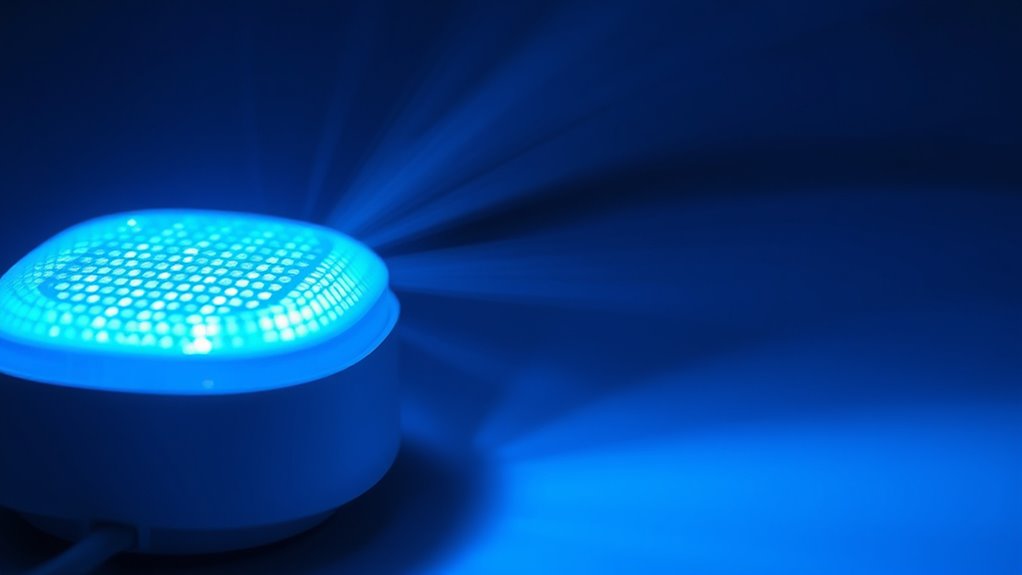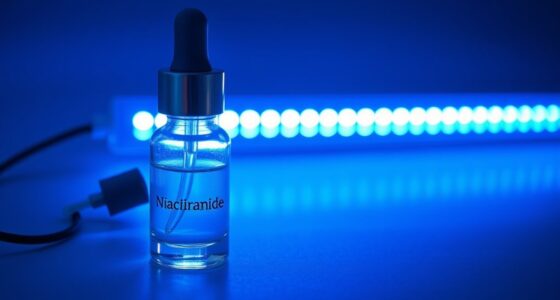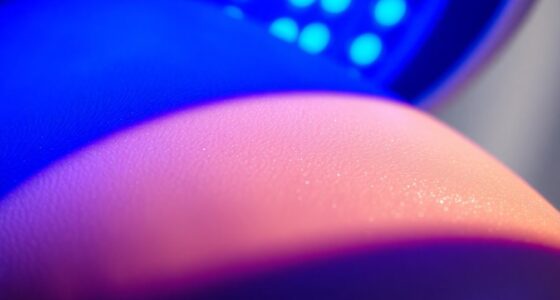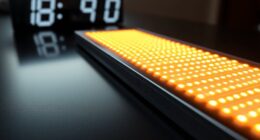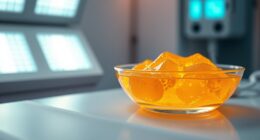Blue light from LED devices influences your circadian rhythm by suppressing melatonin, making it harder to fall asleep and disrupting sleep quality. Exposure during the evening tricks your brain into thinking it’s daytime, which shifts your internal clock later. Over time, this can lead to irregular sleep patterns and potential health problems. To protect your sleep, consider strategies like limiting screen time at night—if you want to find out more, keep exploring how to maintain your natural cycle.
Key Takeaways
- Blue light from LED devices regulates alertness and circadian timing, supporting daytime wakefulness and natural light alignment.
- Evening exposure to LED blue light suppresses melatonin, delaying sleep onset and disrupting sleep quality.
- Prolonged LED blue light exposure can shift the internal biological clock, causing delayed sleep schedules.
- Chronic exposure may lead to health issues like sleep disorders, cognitive impairment, and weakened immune function.
- Mitigation strategies include using night mode, limiting screen time before bed, and wearing blue light filtering glasses.

Blue light, the high-energy visible light emitted by screens and LED lighting, plays a significant role in regulating your circadian rhythm—the body’s internal clock that controls sleep-wake cycles. When you’re exposed to blue light during the day, it helps keep you alert and awake, ensuring your body stays aligned with the natural daylight cycle. However, problems arise when you’re exposed to blue light late into the evening or at night. This exposure can lead to melatonin suppression, which is the reduction of the hormone responsible for signaling your body that it’s time to sleep. When melatonin levels drop, your ability to fall asleep easily diminishes, often leading to sleep disruption. This disruption can make it harder to fall asleep initially and may also interfere with sleep quality, causing you to wake up more frequently throughout the night.
As your circadian rhythm is closely tied to natural light patterns, artificial blue light from LED devices can trick your brain into thinking it’s still daytime. This confusion delays the natural rise of melatonin in the evening, pushing back your sleep schedule. You might find yourself staying awake longer than intended or waking up feeling less rested. Over time, consistent exposure to blue light at night can shift your internal clock, leading to irregular sleep patterns and potential long-term health issues like increased stress levels, impaired cognitive function, and weakened immune response.
You might notice that even a few hours of screen time before bed can impact your sleep. The more blue light you’re exposed to in the evening, the greater the risk of sleep disruption. This is especially true if you use LED devices close to bedtime or live in environments with high artificial lighting. The key to mitigating these effects is to limit blue light exposure during the hours leading up to sleep. Many devices now offer “night mode” settings that reduce blue light emissions, and using blue light glasses or dimming ambient lighting can also help. Creating a wind-down routine that minimizes screen time before bed supports your natural melatonin production, helping you fall asleep faster and enjoy more restorative sleep.
Limiting evening screen time and using blue light filters enhances sleep quality and melatonin production.
Understanding the impact of blue light on melatonin and your sleep cycle empowers you to make smarter choices about device use. By managing your exposure, especially in the evening, you can protect your circadian rhythm, reduce sleep disruption, and enjoy better overall health and well-being.
Frequently Asked Questions
How Does Blue Light Exposure Affect Sleep Quality Long-Term?
Blue light exposure can cause sleep disruption and hormonal imbalance over the long term. When you’re exposed to blue light, especially before bed, it suppresses melatonin production, making it harder to fall asleep and stay asleep. This ongoing disruption can lead to poorer sleep quality, affecting your overall health and mood. To protect your sleep, limit blue light exposure in the evening and consider using blue light filters on your devices.
Are There Specific LED Devices That Emit Less Blue Light?
Yes, some LED devices feature LED spectral tuning and blue light filtering to emit less blue light. You should look for screens with these options, as they reduce blue light exposure and help protect your sleep quality. Many smartphones, tablets, and computer monitors now include settings or special filters that minimize blue light emission, making it easier for you to use devices comfortably without disrupting your circadian rhythm.
Can Blue Light Exposure Impact Eye Health Beyond Circadian Disruption?
Yes, blue light exposure can affect your eye health beyond circadian disruption. It may cause retinal damage over time, increasing your risk of age-related macular degeneration. Additionally, prolonged exposure might contribute to cataract formation by damaging lens proteins. To protect your eyes, consider limiting screen time, using blue light filters, or wearing glasses with blue light blocking lenses. Being proactive helps safeguard your vision from these potential risks.
What Are the Best Strategies to Reduce Blue Light Exposure at Night?
You can reduce blue light exposure at night by limiting your screen time before bed and taking lighting adjustments seriously. Use apps or device settings to activate blue light filters or night mode during evening hours. Dim your room’s lighting and choose warmer, softer lights to minimize blue light. These strategies help protect your eyes and support your circadian rhythm, improving your sleep quality and overall health.
Does Blue Light Influence Hormone Production Besides Melatonin?
Blue light influences hormone production beyond melatonin by affecting hormonal regulation related to your body’s circadian rhythm. Exposure at night can cause circadian disruption, leading to imbalances in hormones like cortisol and insulin. These disruptions may impact your stress levels, metabolism, and overall health. To minimize these effects, limit blue light exposure during evening hours, use blue light filters, and maintain consistent sleep schedules, supporting better hormonal balance and circadian health.
Conclusion
Understanding how blue light influences your circadian rhythm is like steering a delicate dance; each step affects your overall well-being. As LED devices become more common, being mindful of their blue light emissions can help you maintain a healthy internal clock. By adjusting your exposure, you’re steering clear of the stormy seas of sleep disruption. Ultimately, controlling blue light is your compass to a balanced, restful life in a world illuminated by LEDs.
